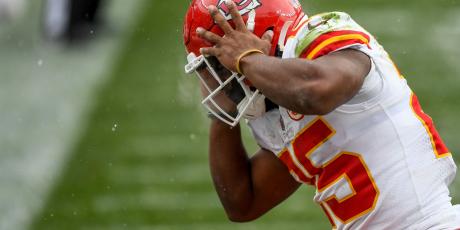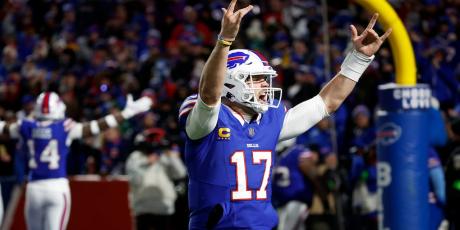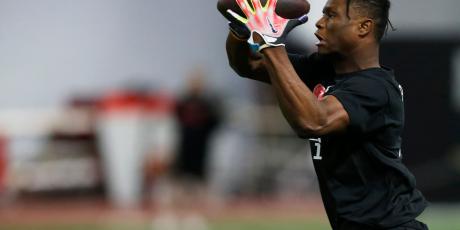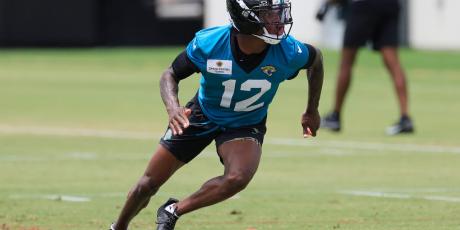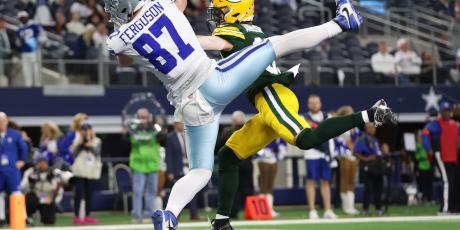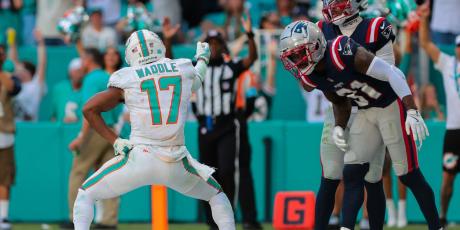John Paulsen's 2015 Draft Day Strategery

In preparation for this year’s Strategery piece, I reread last year’s version to see if there was anything I could glean that might be useful in 2015. The intro struck me as funny. Not so much haha funny, more like hmmm funny.
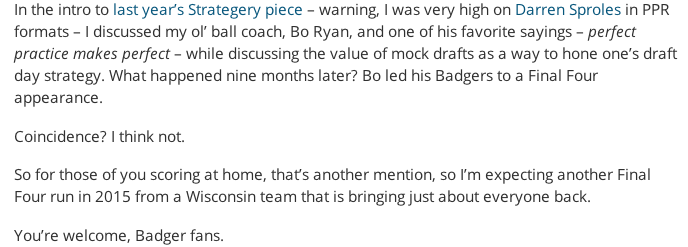
So for those keeping score, that’s two mentions of Bo Ryan and his Badgers and two consecutive Final Four appearances. With Frank Kaminsky and Sam Dekker leaving for the NBA, I think I’ll quit while I’m ahead. But wait, I just mentioned them again, didn’t I? It looks like Coach Ryan has some more work to do.
Moving on…
This is my annual how I’m planning to draft article. The details will change based on scoring system and/or league setup, which is hugely important when putting together a draft plan.
Is your league standard or PPR (or half PPR)? How many points is a passing touchdown worth? What are your starting lineup requirements? (Hint: the more players you have to start at a particular position, the more that position is worth.) Does your league have any wacky scoring settings?
If your league is atypical, it’s good practice to calculate each player’s end-of-season Relative Value (using Value Based Drafting principles). Even better, take a look at the positional distribution in the top 50 or top 75 for the last two or three seasons. This will give you a good idea how important each position is in your league.
How do you calculate RV? It’s pretty simple. Subtract a player’s end-of-season fantasy points from the “last starter” at his position. For example, if your 12-team league requires two starting running backs, you can subtract the fantasy points of the #24 RB (= 12 teams x two starting RBs) in your league from the total for LeVeon Bell. The result is Bell’s RV. Continue until you get to the #24 RB, who will have a RV of zero. Once you have done this for all the players – I recommend getting familiar with a Microsoft product called Excel – you’ll combine the lists and sort by RV. You might find that in your league has 10 quarterbacks in the top 25 every year. In that case, you’ll want to focus on the QB position early on.
Don’t want to do all of this legwork? Don’t worry, 4for4 has you covered with our Full Impact customized rankings. Once you enter your scoring system, the site uses our award-winning projections to construct customized top 200 rankings for your league. Even if you want to use another program (like Draft Hero, which is free with your subscription) to keep track of your draft, it’s helpful to look at the customized top 200 so you know how your league treats the four major positions.
If you play in a typical league (full PPR or standard) with no unusual scoring settings, you can use the basic (but still customizable) Top 200 rankings on the site.
First Steps
Sometimes it seems there are nearly as many draft strategies as there are fantasy analysts. Wait on a QB (a.k.a. Late-Round QB), Stud RB, Upside Down Drafting (a.k.a. Zero RB), TE Early, the list goes on and on. I think it’s important not to get locked into one particular philosophy. Doing so won’t allow for a flexible draft plan to take advantage of value as it emerges throughout the draft.
My draft plan is generally dependent on the makeup of the upcoming season, so it’s important to evaluate the fantasy landscape as a whole before sketching out a strategy. Here are a few things I’ve noticed while preparing for draft season this year:
Quarterback continues to be historically deep.
We are in the golden era of the quarterback, at least from a fantasy perspective. The pocket passers are still well-represented – Peyton Manning, Drew Brees, Ben Roethlisberger, Matt Ryan, Eli Manning, Tony Romo, Philip Rivers, Matthew Stafford, Carson Palmer, Joe Flacco, Sam Bradford and Andy Dalton – while the sheen on the running quarterback – Russell Wilson, Cam Newton, Colin Kaepernick – may be wearing off a bit thanks to Kaepernick’s (and Robert Griffin’s) recent struggles. Then there’s a group of QBs – Andrew Luck, Aaron Rodgers, Ryan Tannehill and Teddy Bridgewater – who not only throw a nice ball, but they can also do some damage with their legs if necessary.
I just mentioned 19 quarterbacks and I’d be content with starting the vast majority of them in Week 1 provided the rest of my lineup is strong.
Since QB is typically a “onesie” position (i.e. owners can only start one), the supply is much higher than the demand, and if I’m remembering my economics class correctly, the price of the position will drop. We can now get a quality fantasy asset like Carson Palmer (who has posted QB1 numbers when healthy over the last two seasons) in the 13th round. The quarterbacks in the #12-#20 range (in ADP) are available into the late 9th all the way into the 13th round (or later, depending on the draft).
There is a drop off after the top three QBs – Andrew Luck, Aaron Rodgers and Russell Wilson – so if Wilson isn’t available in the 6th or 7th round, I’m typically waiting until the 10th or later to draft my quarterback.
There’s strength in this year’s RB2 class.
I’ve written individual articles about C.J. Spiller, Frank Gore, Jonathan Stewart and LeGarrette Blount, but I’d be comfortable starting any of the running backs ranked #13-#28 in PPR or #13-#23 in standard formats. This, coupled with my recent studies about the dependability of early-round receivers versus running backs, has convinced me to generally target a receiver in the first round in my PPR drafts once the top two running backs (LeVeon Bell and Adrian Peterson) are off the board. I do recommend drafting one running back in the first two rounds due to the drop off at the position once Frank Gore and Lamar Miller come off the board. If those two will be available in the 3rd round of your draft, then starting WR/WR is much more feasible.
There’s a steeper drop off at receiver.
When I’m looking only at the first 30 or so picks, there’s a bigger drop off at receiver than there is at running back. The average projected fantasy points (PPR) for the top 5 receivers is 320.2 while the average for the seven readily-available receivers in the 3rd round (Mike Evans, Alshon Jeffery, Emmanuel Sanders, T.Y. Hilton, Brandin Cooks, Jordan Matthews and DeAndre Hopkins) is 250.6. That’s a difference of 69.6 points. Now take the average of Eddie Lacy through Matt Forte (257.0) and subtract the average (227.0) of the 3rd round running backs – Frank Gore and Lamar Miller. The difference is 30.0, so based on our projections, going WR in the 1st and RB in the 3rd holds a 40-point advantage over going RB in the 1st and WR in the 3rd. However, if Gore/Miller aren't available and we're looking at Mark Ingram, C.J. Spiller and Jonathan Stewart (192.3), then the difference is 64.7, which is very close to the drop off between 1st and 3rd round receivers. The takeaway? If you aren't likely to get Forsett, Gore or Miller in the 3rd, then you'll probably want to draft at least one running back in the first two rounds. Owners who want to wait on running back can continue to draft receivers early, but be prepared to scramble for running backs in the 4th-6th rounds.
Tight end is very top-heavy, but there is plenty of value available.
Rob Gronkowski is a fantastic fantasy asset, though since tight end is another “onesie” position, there tends to be a lot of value available late in the draft. This year, Delanie Walker is my 6th-ranked tight end, and he’s typically available into the 10th or 11th round. If he’s not there, Jason Witten makes a fine Plan B. If he's gone as well, I'm pretty content rolling with Tyler Eifert, Austin Seferian-Jenkins or Kyle Rudolph.
Draft Strategy
I’ll be doing my usual Using the ADP Draft Planner series in a few weeks, but for now I’ll discuss my general strategy in different parts of the draft. Let’s assume a 12-team 1-2-3-1 + flex PPR draft, which is pretty similar to the best ball drafts I’ve been doing at MyFantasyLeague.
Early Rounds (1st-5th)
As I mentioned earlier, my research this offseason has convinced me to target more receivers in the first two rounds. Over the years, I’ve always been open to starting my draft with two receivers, but it was typically more of a Plan B than a primary plan.
This season, I’m very likely to draft at least one receiver in the first two rounds, sometimes two. I have nothing against the top tier running backs, and wouldn’t look at an owner funny if they took Marshawn Lynch or C.J. Anderson in the 1st round. But due to positional dependability and relative value, I’d rather have Demaryius Thomas, Odell Beckham or Dez Bryant.
If I do draft a receiver in the 1st, then I’m more likely to target a running back like Justin Forsett in the 2nd.
The Forsett Tangent: Forsett should see his PPR upside increase due to new OC Marc Trestman's tendency to use his running backs in the passing game. Under Trestman, Matt Forte caught 176 passes in the last two seasons, including 102 catches in 2014. Forsett caught 44 passes last season, and could potentially see that number double if he remains the RB1 for the Ravens in 2015. Trestman has promised that the rest of the running game should stay intact, so I’m expecting big things from Forsett in 2015.
The 3rd round is a good spot for Frank Gore [article] or Lamar Miller at running back, but their ADP has been rising towards the 2nd round. Mike Evans, Alshon Jeffery, Emmanuel Sanders, T.Y Hilton, Brandin Cooks, Jordan Matthews or DeAndre Hopkins at receiver. (Note: Former 3rd-rounder C.J. Spiller is now dropping into the 4th round after undergoing a knee scope, which I believe is no big deal. You can quote me on that, though I may deny it.) My main target in the 4th round is Julian Edelman, so I try to keep that in mind when making my first three picks. Do I want Edelman as my WR2 with two RB picks in the first three rounds or is he better as my WR3 with only one RB pick in the first four rounds? If I can start four receivers, then I’m more likely to take Edelman as my third WR.
The Edelman Tangent: Edelman missed a couple of games last season, but still managed 92 catches for 972 yards and four touchdowns. When we include the playoffs, his per game averages extrapolate to 111 catches for 1,179 yards and 4.7 touchdowns. Those are fringe WR1 numbers in PPR leagues and solid WR2 numbers in standard formats. Expect more of the same in 2015, though Tom Brady’s suspension may lead to a slow start if Jimmy Garoppolo isn’t able to fill in adequately.
There seems to be a drop off in the 5th round at receiver and running back, especially since I love the value that Larry Fitzgerald represents in the 7th/8th, but more on that later. So it’s not a bad spot for Travis Kelce if he’s still on the board and no one else is really jumping out. Greg Olsen doesn’t have Kelce’s upside, but he’s dependable.
Kelce is usually gone, so I’m typically drafting a second or third running back in the 5th round, and it’s usually Ameer Abdullah, who appears to be slated for the Reggie Bush role in the Detroit offense. He has some upside from there if Joique Bell continues to miss time in his recovery from knee and Achilles injuries. (Note: Abdullah has been going in the 4th round lately.)
The Davante Tangent: With Jordy Nelson out for the year with a torn ACL, suddenly 28 percent of the targets from the best quarterback in the world are up for grabs. I believe most of these will go to Adams, who has drawn raves from both Aaron Rodgers and head coach Mike McCarthy this offseason. Prior to the injury, McCarthy said he was looking for “big things” from Adams, and named him the MVP of OTAs. Meanwhile, Rodgers said that Adams “has star potential” and “humongous upside.” He has received at least five targets in five career games, averaging 6.2 catches for 88 yards and 0.2 TD. It’s a small sample size, but still impressive. I moved Adams up to #17 in PPR formats and #18 in standard with a projection of 81-984-7.5. So I believe he’s worthy of a pick in the early 5th. His ADP is going to climb into the middle rounds, but I doubt he’ll surpass Jordan Matthews, Keenan Allen, Andre Johnson or Golden Tate, though stranger things have happened. For owners who want to draft three running backs in the first four rounds, I’d feel good about adding Adams as my WR2 in the 5th.
Ideal Beginning: Antonio Brown, Justin Forsett, Frank Gore/Lamar Miller, Julian Edelman, Travis Kelce
Middle Rounds (6th-10th)
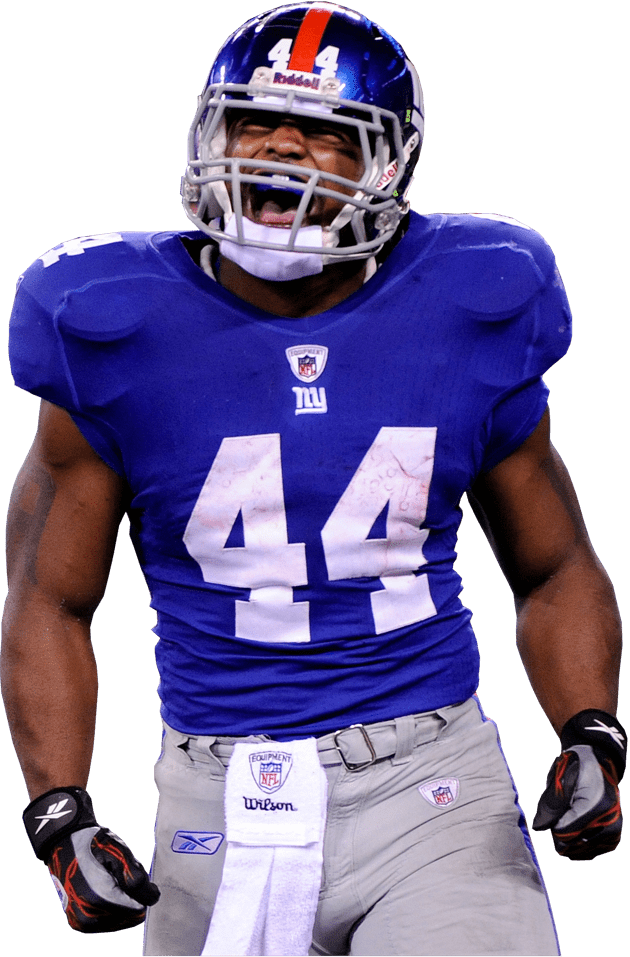
- All Premium Content
- The Most Accurate Rankings Since 2010
- Expert Draft Picks w/ Draft Hero
- Highest Scoring Lineup + Top Available Players w/ LeagueSync
- ...and much more!

